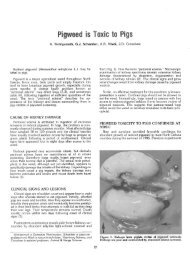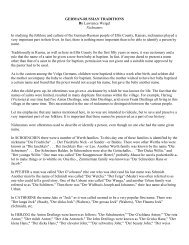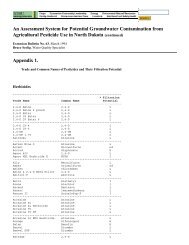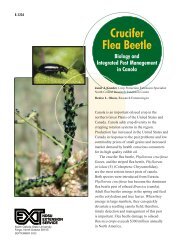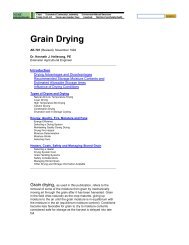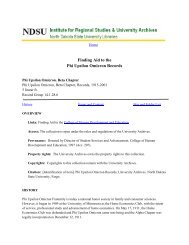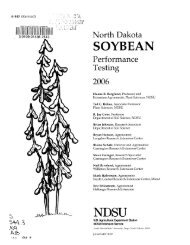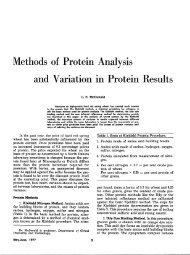germans from russia in fort collins, 1900-2000 - Libraries
germans from russia in fort collins, 1900-2000 - Libraries
germans from russia in fort collins, 1900-2000 - Libraries
You also want an ePaper? Increase the reach of your titles
YUMPU automatically turns print PDFs into web optimized ePapers that Google loves.
WORK RENDERS LIFE SWEET: GERMANS FROM RUSSIA IN FORT COLLINS<br />
settlement <strong>in</strong> Ellis County, Kansas, Albert<br />
Peterson found several characteristics <strong>in</strong><br />
common to the homes of Germans <strong>from</strong><br />
Russia. Those features were a hipped roof;<br />
two-over-two, double-hung sash w<strong>in</strong>dows;<br />
and mud-brick or stone construction. The<br />
most notable feature was the Volga architrave,<br />
seen most often as a w<strong>in</strong>dow surround.<br />
58 Because Andersonville and<br />
Buck<strong>in</strong>gham have been home to Hispanic<br />
families s<strong>in</strong>ce the 1920’s, it is difficult to<br />
determ<strong>in</strong>e if the adobe construction present <strong>in</strong><br />
them corresponds to their occupation or to the<br />
Germans <strong>from</strong> Russia. However, many of the<br />
early homes <strong>in</strong> Andersonville and those built<br />
after the flood <strong>in</strong> Buck<strong>in</strong>gham had hipped<br />
roofs and usually front and back porches,<br />
accord<strong>in</strong>g to Joan Zimmerman Anderson. The<br />
hipped-box type was ubiquitous to Colorado,<br />
but was also strongly identified with<br />
Germans <strong>in</strong> Russia and their settlements<br />
throughout the western United States. If the<br />
lot was large enough, a German-Russian family<br />
often constructed a summer kitchen apart<br />
<strong>from</strong> the ma<strong>in</strong> house. This tradition was also<br />
carried over <strong>from</strong> Russia, where each family<br />
compound <strong>in</strong>cluded a courtyard with a<br />
Sommerkuche. But <strong>in</strong> general, most German-<br />
Russian houses <strong>in</strong> Colorado were simple and<br />
organic – added onto as the family grew or as<br />
money allowed. 59<br />
Despite the cramped liv<strong>in</strong>g conditions,<br />
hard-packed dirt floors, the filth of the beet<br />
fields, and the stench of rott<strong>in</strong>g beet pulp,<br />
Germans <strong>from</strong> Russia kept their houses – and<br />
neighborhoods – as immaculate as possible.<br />
Indeed, Sykes’s Second Hoe<strong>in</strong>g drew the<br />
most criticism <strong>from</strong> Germans <strong>from</strong> Russia for<br />
its portrayal of their families as dirty and disposed<br />
to thievery. Kloberdanz argues that the<br />
cleanl<strong>in</strong>ess of German-Russian homes was<br />
“an extremely touchy subject’” with<strong>in</strong> the<br />
community at the time of the novel’s publication:<br />
…The epithet “dirty Rooshun” frequently<br />
was hurled at self-conscious Volga-<br />
German immigrants regardless of their<br />
physical appearance. …With<strong>in</strong> the tightly<br />
knit Volga-German communities<br />
(where ridicule was an effective means<br />
of <strong>in</strong>formal social control), dirt – like<br />
theft – was anathema. The allegation<br />
that German Russians were dirty was<br />
viewed by more astute members of the<br />
group as a way for American landowners<br />
to justify the chicken coops, boxcars,<br />
and sordid tarpaper shacks that had been<br />
given large Volga-German families as<br />
liv<strong>in</strong>g quarters.60<br />
Even a 1923 <strong>in</strong>vestigation by the United<br />
States Department of Labor, seek<strong>in</strong>g the most<br />
dismal of liv<strong>in</strong>g and work<strong>in</strong>g conditions,<br />
admitted that German-Russian-owned houses<br />
were particularly tidy: 61<br />
The houses owned by<br />
the laborers, though<br />
seldom more than<br />
one story high and<br />
often conta<strong>in</strong><strong>in</strong>g only<br />
two or three rooms,<br />
were as a rule clean,<br />
well-kept little<br />
places, frequently<br />
very attractive, with<br />
good furniture, bright<br />
rugs or new l<strong>in</strong>oleum,<br />
lace curta<strong>in</strong>s, and<br />
plants <strong>in</strong> every corner.<br />
However, the<br />
report found that<br />
farmer- and companyprovided<br />
hous<strong>in</strong>g was<br />
often miserable, rat<strong>in</strong>g<br />
over a third of the structures<br />
“<strong>in</strong> poor condition,”<br />
lack<strong>in</strong>g even<br />
basic weatherproof<strong>in</strong>g.<br />
62 Thus, one can conclude that not only<br />
were German-Russian-owned houses larger<br />
and more sophisticated than company- or<br />
Figure 9.<br />
Volga architrave as a w<strong>in</strong>dow surround.<br />
(Illustration by the author.)<br />
SWCA Environmental Consultants Page 16



